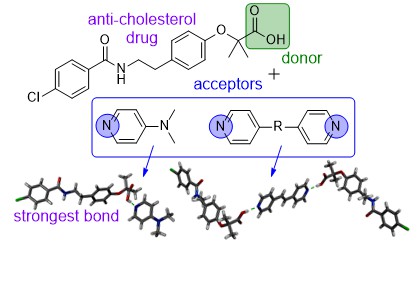Research in the Hutchins group is inspired by the way in which nature utilizes reversible, non-covalent interactions such as hydrogen bonding and metal coordination to create large, functional structures (e.g. DNA double helix, hemoglobin).
Students in the Hutchins group will gain skills in molecular design, organic and polymer synthesis, and a variety of diffraction, imaging, and spectroscopic characterization techniques. Importantly, students will also strengthen their scientific writing and communication techniques while doing research in our group. Our group focuses on three main research areas (below). We are also grateful to the following funding agencies who have supported our work!




Thermal Expansion Behavior in Organic Materials:
Molecular recognition is the occurrence of a specific interaction between at least two molecules via noncovalent interactions such as hydrogen bonds, halogen bonds, or metal coordination. The high specificity and inherent reversibility of noncovalent interactions makes molecular recognition a powerful tool in constructing materials that exhibit dynamic properties. We focus on addressing the self-assembly of individual organic molecules into multi-component solids (e.g. salts, cocrystals, networks) with control over the intermolecular interactions that sustain the solid in multiple dimensions. We aim to develop correlations between structure, noncovalent interactions, and resulting thermal expansion properties. Molecules containing functional groups that are capable of undergoing motion in the solid state are synthesized and characterized to understand how motion can be turned ON or OFF in a controlled manner. We also address fundamental self-assembly of organic molecules into defined one-dimensional (1D), 2D, and 3D structures using noncovalent interactions, and the effects of tuning these interactions on resulting structures and thermal expansion properties.


Understanding and Improving Properties of Pharmaceuticals
We are using cocrystallization and mechanochemistry to investigate pharmaceuticals with a focus on developing tools for achieving and controlling crystallization and improving properties of pharmaceuticals. The project focuses on constructing solids by using supramolecular synthons - intermolecular forces known to assemble structural components in a pre-designed manner as a platform for modifying and controlling solid-state properties of drug molecules. We are also interested in controlling polymorphism and using mechanochemistry to synthesize and control solid-state forms.


Materials that Capture Contaminants or Valuable Resources
Removing contaminants from the environment is an important and critical problem. Our research aims to develop macromolecular materials that engage in noncovalent interactions with contaminants or compounds that could be reused. The project focuses on a shift in strategy, from one that relies on nonspecific adsorption to one that constructs materials designed to bind compounds through specific interactions. Currently, our group is focusing on removal of pharmaceutical contaminants and recycling rare-earth elements.


